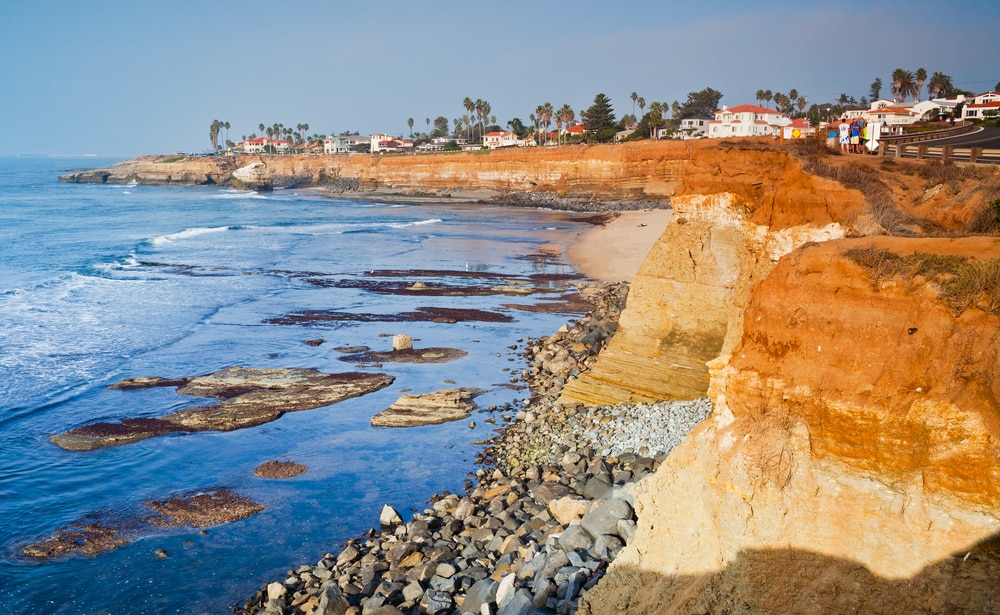
Unique History of San Diego Parks – Part 2
You probably visit San Diego parks often for any number of reasons, whether it be to go for a walk, have a picnic, or get some outdoor exercise. Many people visit their local park regularly but often don’t know the park’s unique history.
In this two-part series, we’re digging into some of the more interesting stories behind San Diego parks we love.
Trolley Barn Park
(map)
Off Adams Avenue in University Heights is a nice but unassuming little park on the bluff called Trolley Barn Park. It’s a wonderful place to throw a frisbee, kick a soccer ball around, or do some outdoor yoga in the shade of the eucalyptus trees.
The park got its name because it quite literally used to be the home of a large brick trolley barn. These trolleys served a network of San Diego streetcar lines that went from what is now City Heights, through downtown and all the way out to Pacific Beach and La Jolla. The streetcars remained operational until 1949 when many of the tracks were dug up and streets repaved to make way for cars and buses.
The areas adjacent to the park have a unique history of their own and the whole area was a popular day-trip destination for people coming up from downtown.
Right across the street from the trolley barn was Harvey Bentley’s Ostrich Farm, which even allowed visitors to ride the ostriches. This is also the source of the ostrich motif you can see on street signs in the neighborhood. Immediately to the northwest of the trolley barn was Mission Cliff Garden, a beautifully landscaped garden overlooking the meandering path of the San Diego River through what is now called Mission Valley.
Also if you ever wondered why the neighborhood is called University Heights, that’s because the original campus of San Diego State University was located at the confluence of Washington St, Park Blvd, and El Cajon Blvd, in what is now the San Diego Unified School District Administrative Office building.
Tecolote Canyon Natural Park and Nature Center
(map)
If you want to go back a little farther in time–as in geological time–take a trip to Tecolote Canyon Natural Park and Nature Center.
The canyon is a wonderful neighborhood hike, but it also sits on an active fault line! Right near the trailhead off Tecolote Road you can see the space where the active Rose Canyon fault brings 50 million-year-old earth together with 500,000-year-old earth. The fault itself runs along the length of the San Diego coast, cutting inland south of Coronado, heading north through Old Town, Bay Park, and La Jolla before heading back out to the ocean. It’s considered to be an active and potentially dangerous fault-line for San Diego should it ever slip.
Another worthwhile site to visit while you’re there is the Kumeyaay village exhibition, with models and information on day-to-day Kumeyeay life that took place in the same canyon for hundreds of years before European colonization.
Spalding Park / Sunset Cliffs Natural Park
(map)
If you’ve ever taken a walk or gone for a run along the length of Sunset Cliffs Blvd in Ocean Beach, you’ve undoubtedly marveled at the various coves, outcroppings, rock formations, and even caves dotting the length of the coastline. And surely you’re not the first to develop this appreciation.
In the early 1900s a man by the name of Albert Spalding set up residence near what we now called Sunset Cliffs. He had made a fortune for himself as a baseball equipment manufacturer. If you’ve ever played baseball you’ve most likely thrown a ball, swung a bat, or worn a glove with his name on it.
Spaulding eventually built features on Sunset Cliffs to make them accessible for all to enjoy, including benches, shade structures, pools, and even bridges to various outcroppings. He hired renowned Japanese architects to give the structures a unique and beautiful look and had them built in such a way as to accentuate the natural environment rather than take it over.
He spent $2 million dollars on the improvements, a huge sum at the time. And while very few of his additions to the coastline remain today, he did play a crucial role in preserving public access to a beautiful stretch of coastline that might have gone to the highest bidder otherwise.
Tweet Street Linear Park in Cortez Hill
(map)
Due to its location, it’s not a park you would normally find yourself in, but if you’re ever in Cortez Hill, stop by Tweet Street Linear Park.
Built in 2008, it gets its name from the many handmade, eccentrically designed birdhouses hanging in the trees throughout the park.
The birdhouses were all donated by volunteers hoping to attract native birds in search of a place to roost and add some wildlife to the neighborhood. The park also features aluminum signs and banners depicting some of the local birds you might see.
The end result is a fun and whimsical park on what would have otherwise been an unused freeway easement. It even won a prestigious Orchid Award from the San Diego Architectural Foundation. The language in the award called it “an urban gem that steals back an unused Caltrans right-of-way to create a much-needed shady green space. Bravo!”
___
If you missed part one of our History of San Diego parks series, go here to read it.

Join our Senior Wellness Society for the latest news on Medicare and tips for healthy living in San Diego!
Sign up now ›Are you looking for specialized medical care in San Diego?
Our directory has more than 850 doctors in San Diego County of various specialties who are available to help you.
Find a doctor